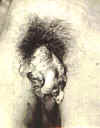|
Abortion |
FETAL AND NEW BORN AUTOPSIES
This principle is much more diffuclt and require good knowledge of developmental anatomy to achive the aims and objectives of the post mortem examination.
The main objectives are :
1. If the fetus under examination is human.
2. What is the age of fetus or newly born? i.e., more than 280 days of gestation.
3. Verse the recently born was capable of existence.
4. At birth recently born was alive.
5. If born alive how long he survived.
FORENSIC ANATOMY
1. Embryonic stage, is the age in the intrauterine is from the day of conception to 56 days.
2. The fetal age starts from the end of xxx embryonic age to the end of period of gestation that is ten lunar months or nine calender month.
ABORTION MISCARRIAGE, DEAD AND STILL BORN
1.In the modern literaturs expulsion of product of conception at any stage is term as abortion. The medical termination of pregnancy act uses the term abortion in this contest.
2.Anatomically expulsion of product of conception upto a fetal age till the age of vibility that is 210 days could be turmed as abortion while afterr that age the term miscarriage should normally accepted with modern methods are available. A premature can be made to survive. The miscarriage normally corresponds to premature labour.
Any new born having a weight of 10000 grams is cosidered premature as per WHO prescribe standard not likely survive.
The autopsy of such product of conception is necessary from the point of view of estimation of age as legal requirement attracting the penal laws, such as mother quick with child, age of vibility, any conginital anamoly etc.
PHYSICAL STANDARDS IN INTRUTERINE LIFE AN AT BIRTH
Third to nine month described as full term. The new born will have the following anatomy standards -
1. Weight average - 2.5 kg.
2. Length - crown and heel average - 50 cms.
3. Curcumference of the head average -
4. Weight of placenta nearly average - 456 g
5. Diameter of placenta - 15 to 18 g
6. Volume of placenta - 500 ml, range 202 g, diameter 185 mm, thickness 23 mm - range 10 to 40 mm, average surface area 30,000 mm2, physical look - thickest in the centre and rapidly deminicious in thickness perfectly.
It has mental surface has 15 to 30 lobes called cotyledons which are seperated by septa indicated by groove.
Length of Umbilical Cord
At the third month (fetal size 31 mm to 60 mm) average length 6 cm. At full term average 54 cm, range 18 to 122 cm (Walker p-1960, Boyd p-127).
Placenta (plakuos = Placenta = cake).
FETAL GROWTH
The length of pregnancy 10 lunar months or 280 days or 40 weeks after the onset of last mentruation or more acurately 260 days or 38 weeks after fertilization.
MONTHLY xxx IN ANATOMY
One of the most striking change is relative slow down in growth of the head compare is relative slow down in growth of the head comparre to the rest of the body. For example, the head is 1-1/2 of the CR length at the beginning of the third month but by the beginning of the fifth month is 1-1/2 and at birth approximately 1-1/4 of the CR length. The face in the third month looks like human, the eyes and ears take a definite position in the rest of the body, external xxx area develops so that by the end of third month, rest of fetal length be determined by the external examination.
During the fourth and fifth - The CR length is approximately 15 cm, i.e., about 1/2 of the fetal length of new born, by the end of fifth month 500 g. The fetus is covered with xxx called Lanugo. Elbows and head are also visible and the mother at the end of fifth month can recognise the moment.
The last 2-1/2 month 50% of the full term weight approximately 3200 g is added. In the sixth the skin of fetus is reddish and has wrinkled xxx because of the underline connected to shoe. The respiratory and central nurvous system has not reached is functional coordinating age.
By the end of intrauterine life the skin whitish fatty substance (cervix caseosa) at the end of nine month the CR length is about 36 cm and CH length 50 cm.
CIRCULATING CHANGES AT BIRTH RELATED TIME
The blood from placenta is saturated with 80% oxygen and return to the fetus by the umbilical vain. close to the entrance of the umbilical vain the ductus venosus closes. The sedation of placental flow triggers the lung respiration in support of the cerculation the shunt between the pulmonary artery on aorta pressure and reduction xxx producing closer of the foramon oval.
Umbilical artries with in view minutes after birth but gratual closer begins 2 and 3 months before the remenent of these vessels is the leded umbilical legends. The closer of the umbilical vain soon after birth kill the regamentum teres.
The complete anatomical xxx of the ductus arterioses forming the legamentum artiriosum which takes about one or three months.
OBSTETRIC TERMINOLOGY
500 gms. 1kg. 2.5 kg.
conception---20 wks.---28 wks.---37 wks.---42 wks.--->42 wks. |
abortion immature premature term postmature
Abortion : The termination of pregnancy before the fetus reaches age of viability . The legal defination of viability differs from state to state , usually 20 to 24wks .
Miscarriage : Lay term for termination of pregnancy at any time before the fetus has attained extrauterine viability . Usually refers specifically to expulsion of fetus in period between fourth month and viability .
Live birth : A term used for statistical purposes indicating an infant born with signs of life , such as heart beats ,
respiration , or movement of voluntary muscles .
Premature Birth : An infant who at birth is not fully developed because of curtailed gestation ,ie gestation less


